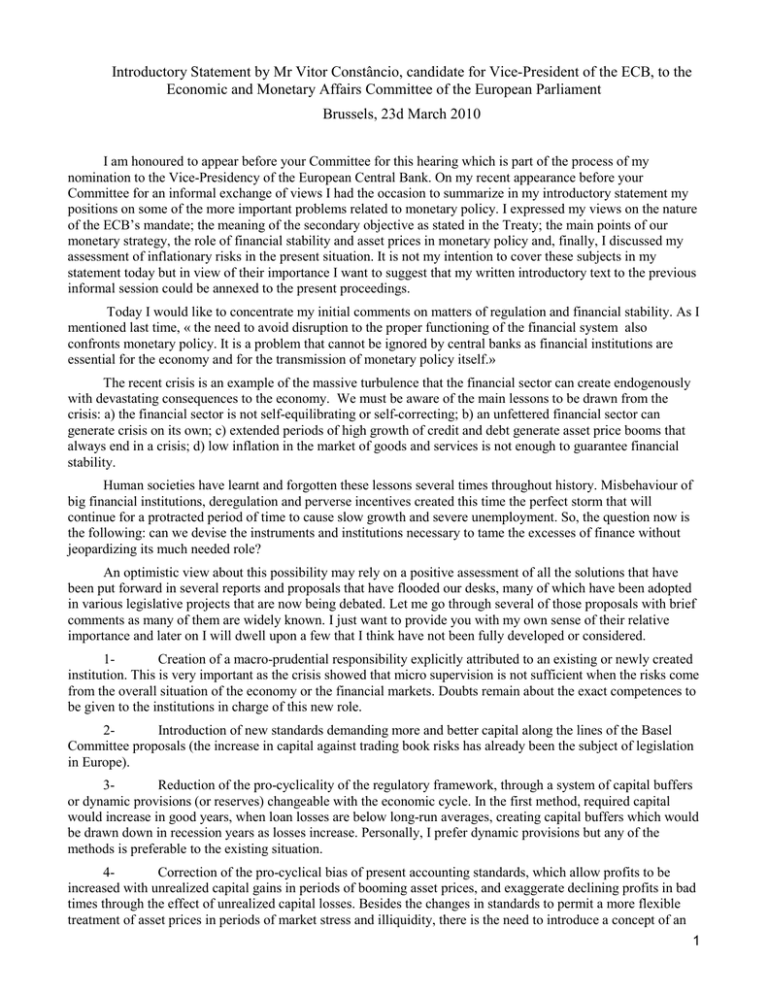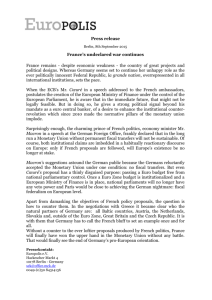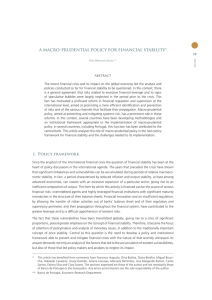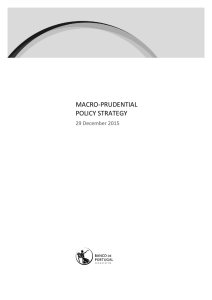Introductory Statement by Mr Vitor Constâncio, candidate for Vice-President of... Economic and Monetary Affairs Committee of the European Parliament
advertisement

Introductory Statement by Mr Vitor Constâncio, candidate for Vice-President of the ECB, to the Economic and Monetary Affairs Committee of the European Parliament Brussels, 23d March 2010 I am honoured to appear before your Committee for this hearing which is part of the process of my nomination to the Vice-Presidency of the European Central Bank. On my recent appearance before your Committee for an informal exchange of views I had the occasion to summarize in my introductory statement my positions on some of the more important problems related to monetary policy. I expressed my views on the nature of the ECB’s mandate; the meaning of the secondary objective as stated in the Treaty; the main points of our monetary strategy, the role of financial stability and asset prices in monetary policy and, finally, I discussed my assessment of inflationary risks in the present situation. It is not my intention to cover these subjects in my statement today but in view of their importance I want to suggest that my written introductory text to the previous informal session could be annexed to the present proceedings. Today I would like to concentrate my initial comments on matters of regulation and financial stability. As I mentioned last time, « the need to avoid disruption to the proper functioning of the financial system also confronts monetary policy. It is a problem that cannot be ignored by central banks as financial institutions are essential for the economy and for the transmission of monetary policy itself.» The recent crisis is an example of the massive turbulence that the financial sector can create endogenously with devastating consequences to the economy. We must be aware of the main lessons to be drawn from the crisis: a) the financial sector is not self-equilibrating or self-correcting; b) an unfettered financial sector can generate crisis on its own; c) extended periods of high growth of credit and debt generate asset price booms that always end in a crisis; d) low inflation in the market of goods and services is not enough to guarantee financial stability. Human societies have learnt and forgotten these lessons several times throughout history. Misbehaviour of big financial institutions, deregulation and perverse incentives created this time the perfect storm that will continue for a protracted period of time to cause slow growth and severe unemployment. So, the question now is the following: can we devise the instruments and institutions necessary to tame the excesses of finance without jeopardizing its much needed role? An optimistic view about this possibility may rely on a positive assessment of all the solutions that have been put forward in several reports and proposals that have flooded our desks, many of which have been adopted in various legislative projects that are now being debated. Let me go through several of those proposals with brief comments as many of them are widely known. I just want to provide you with my own sense of their relative importance and later on I will dwell upon a few that I think have not been fully developed or considered. 1Creation of a macro-prudential responsibility explicitly attributed to an existing or newly created institution. This is very important as the crisis showed that micro supervision is not sufficient when the risks come from the overall situation of the economy or the financial markets. Doubts remain about the exact competences to be given to the institutions in charge of this new role. 2Introduction of new standards demanding more and better capital along the lines of the Basel Committee proposals (the increase in capital against trading book risks has already been the subject of legislation in Europe). 3Reduction of the pro-cyclicality of the regulatory framework, through a system of capital buffers or dynamic provisions (or reserves) changeable with the economic cycle. In the first method, required capital would increase in good years, when loan losses are below long-run averages, creating capital buffers which would be drawn down in recession years as losses increase. Personally, I prefer dynamic provisions but any of the methods is preferable to the existing situation. 4Correction of the pro-cyclical bias of present accounting standards, which allow profits to be increased with unrealized capital gains in periods of booming asset prices, and exaggerate declining profits in bad times through the effect of unrealized capital losses. Besides the changes in standards to permit a more flexible treatment of asset prices in periods of market stress and illiquidity, there is the need to introduce a concept of an 1 Economic Cycle Reserve, along the lines proposed in the Turner Review, calculated with the same method used in the previous item (3), in order to set aside profit in good times to reduce losses in depressed economic cycles of the future. It is indeed necessary to affect the accounting reports in order to avoid that volatile unrealized gains influence share prices and consequent behaviour of financial institutions. 5capital) 6- Introduction of a new maximum absolute leverage ratio (risk unweighted total assets over total Introduction of new regulations about liquidity ratios as proposed by the Basel Committee. 7Prevention of the development of a «shadow banking» sector by enlarging the perimeter of regulated institutions, like hedge funds, and reinforcing consolidation accounting rules. 8Tightening securitization regulations to avoid its misuse, its complexity, and opaqueness that prevented it from performing as predicted to diversify and dilute risk. What happened with subprime mortgage bonds, CDOs and Credit Default Swaps was appalling and should not happen again. 9Reduction of the reliance for official regulatory purposes on Rating Agencies that have contributed to the pro-cyclicality of the financial sector and played a very negative role in the subprime crisis. The mere registration and monitoring of their activity and the elimination of conflicts of interest may not be sufficient to correct their performance. 10Introduction of new principles regarding risk management and remuneration guidelines to correct prevailing perverse incentives with an excessive short-term perspective. With the exception of points 4 and 9, most of these aspects of a new regulatory environment are being developed by European Union institutions or the Basel Committee, subsequently to general guidelines prepared by the Financial Stability Board and approved by the G20. It would seem then that the work has been progressing in the right direction to create a more resilient and efficient financial system. Nevertheless, I want to make a few comments on aspects that I consider more important or are being insufficiently addressed. The first point refers to the assessment of whether the new rules are sufficient to prevent the excesses of finance and, in particular, whether the macro-prudential function is being implemented in a really efficient way for the same purpose. My answer tends to be positive because instruments like the gross leverage ratio, the capital buffers, the liquidity ratios and the discretionary use of Pillar II may be enough for the task. The remaining necessary instruments are related with the «too big to fail» problem that I address bellow. Regarding macroprudential policy, it looks as if in all countries the institution in charge will be limited to making warnings and recommendations. In Europe, the proposed composition of the European Systemic Risk Board (ESRB) with the inclusion of the Commission and the 3 ESA representatives should ensure that this may not become a problem, guaranteeing at the same time the necessary coordination between the micro and macro levels. The whole setup may work well enough for us to hope that the macro-prudential function will not be reduced to warnings, sermons and regrets... I have been following with great interest the debate in your Committee about the ESRB and if you permit me I would like to stress two points that I consider very important for the efficient functioning of the new entity. The first regards the need for the Steering Committee to accurately reflect the composition of the General Board in order to avoid unnecessary tensions. The second refers to the importance of keeping the proposed composition of the Advisory Technical Committee since its main role will be to prepare the work of the General Board and it will be more efficient if composed of people who work in the institutions actually in charge of regulation and supervision. If you consider that a scientific committee is necessary it can always be added to the whole setup without eliminating a necessary component of the preparatory work for the General Board. The second point I wish to comment upon relates to the need to move trade in credit derivatives, especially trade in credit default swaps (CDSs), to organized exchanges. CDSs were at the centre of the crisis and were responsible for the demise of important institutions. They are obscure products, as they are transacted «over the counter» (OTC) and the premiums so widely quoted are not prices of actual transactions but mere «quotations» sent to a private firm that started to publish indexes in 2001. The exact way these indexes are built, the «players» sending the quotations are not publicly known and, finally, as they are «quotations» in a non-organized market, the institutions providing these «quotations» are not compelled to make transactions at these levels. Myron 2 Scholes, the Chicago Professor and Nobel Prize of Economics, the co-author of the Black-Scholes formula for option pricing and a kind of godfather to derivatives, said last year: «the solution is really to blow up or burn the OTC market, the CDSs and swaps and structured products and let us start over». Serious thought should also be given to the possibility of forbidding «naked short selling» of these instruments, allowing only market-maker institutions to do such transactions as hedging activity when they already have transactions with agents who possess a real insurable interest. The third aspect I want to address is the «too big to fail» problem. The existence of large and complex financial institutions (LCFI) whose bankruptcy is «impossible» to allow, creates a huge problem of moral hazard that may lead to unduly risky behaviour. It’s an intricate question and there is still no international consensus on how to deal with it. The problem is even becoming potentially worse by the increase in size of surviving institutions a situation that is common after a crisis. Without dwelling upon the arguments, let me state that I do not believe that the problem can be solved by a policy of systematic break-up of big institutions or by adopting a solution of protecting only «narrow banks» and distinguishing between «utility» and «investment» banks. This means that I only believe in solutions that may contribute to transform the concerned entities in institutions «too good to fail» or that can organize, with special powers, an orderly resolution that avoids the more negative consequences of insolvency. The following proposals, not mutually exclusive, have been discussed or are already included in legislative projects: a) More intense and special supervision, including from a macro-prudential perspective. b) Higher capital requirements. This idea includes several possibilities: from a simple capital surcharge according to size and/or related to the bank’s contribution to systemic risk. In some schemes, these additional capital requirements can be in part satisfied through contingent capital securities (bonds automatically converted into equity when certain conditions are met). c) Insurance premiums. On top of higher capital, big institutions should pay insurance costs related to their size or contribution to systemic risk, with the proceeds of the insurance in case of insolvency reverting to the authorities in charge of the resolution of the crisis. A variant of these idea, already adopted in the US House of Representatives, consists in demanding from the banks contributions to a Resolution Fund to support the costs of insolvency problems in «systemically important financial institutions» (SIFIs). d) Living wills. This consists in compelling the SIFIs to have permanently prepared plans for a orderly resolution. e) Creation of a special resolution regime, giving an institution like the American FDIC (Federal Deposit Insurance Corporation) wide powers to take over a troubled institution and restructure and sell or liquidate it. In some proposals, the special powers should include the possibility of compulsory transformation of bonds into equity to recapitalize the institution. The institution responsible for this role will need to have access to a Restructuring or Resolution Fund. Elements of these five types of measures can be found in existing legislative proposals, although there is no international consensus to achieve a more harmonized regime that could be relevant for cross-border institutions. All these measures seem to be useful and complement the other instruments already mentioned to rein in excessive growth and unduly risky behaviour of major institutions. The fourth and final problem that is not yet completely solved refers to crisis resolution of cross-border institutions in the European Union. The creation of colleges of supervisors and the possible role of the ESAs in acting as mediators will make a contribution to find coordinated solutions to the problem. The main obstacle is related to the problem of burden-sharing of costs in dealing with crisis resolution. As I wrote in my answers to your questionnaire: « In my view, any potential move towards an even more integrated supervisory architecture in Europe will therefore have to be preceded by the establishment of a European safety net (including an ex-ante funded Resolution Fund) » The Commission has been doing good work in this area and the announcement made last Friday by Commissioner Barnier goes in that direction and is very important. Nevertheless, let me point out that a full solution and the operation of such a fund requires higher harmonization of national resolution regimes including bankruptcy laws, and this will prove to be difficult. Nevertheless, I believe that full European financial integration requires a common European resolution regime. 3 A final thought about the overall impact of all the envisaged regulatory reforms. Some commentators make the criticism that all the measures at stake could amount to a sort of overkill that may possibly choke financial activity. In view of the extreme seriousness of the financial crisis engineered by the financial sector I think that there is no exaggeration in the re-regulating efforts being prepared even if they were fully implemented – something about which one may have doubts. There is nevertheless a risk to be avoided concerning the timing of the implementation. An immediate or quick implementation of all the measures, in particular those related with higher capital requirements, could generate credit supply restrictions detrimental to economic recovery. This implies that all authorities concerned should be as clear-headed and resolute regarding content of the reforms as they must be wise and prudent in timing their implementation. 4








